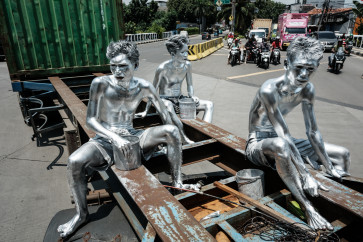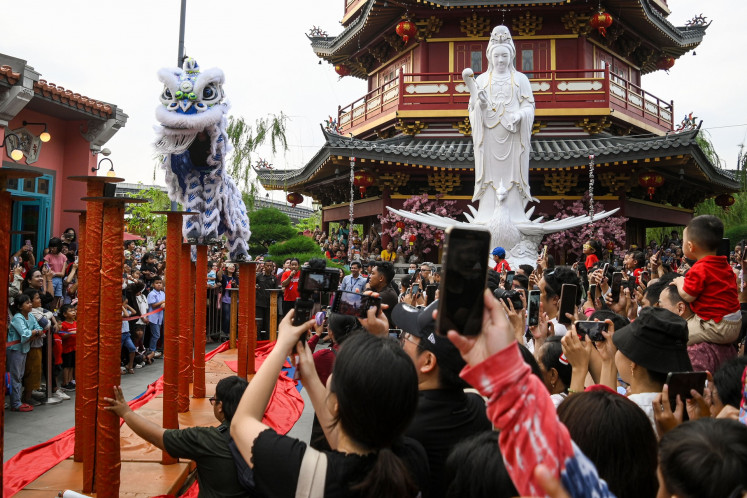Flavors of Betawi
They wake up to a cup of coffee and a plate of gemblong (glutinous rice cakes glazed with palm sugar) and cucur (rice flour and palm-sugar cake)
Change text size
Gift Premium Articles
to Anyone

T
hey wake up to a cup of coffee and a plate of gemblong (glutinous rice cakes glazed with palm sugar) and cucur (rice flour and palm-sugar cake).
Sometimes they have nasi uduk (rice cooked with coconut milk) for breakfast. A few hours after lunch, they sit in the shade of trees, chat and drink another cup of tea or coffee with some traditional cakes.
The cakes could be traditional Betawi cakes like sengkulun (glutinous rice and sagu flour cooked with palm sugar and pandan leaves) or other common cakes like combro (fried cassava rolls stuffed with fermented soybeans) and fried cassava.
This relax-and-have-some-snacks-activity is called nyahi in Betawi. Those were the regular snacks in Betawi households in the old days. Back then, many of them had large yards and worked as dairy owners, batik artists or traders.
Betawi observer Yoyo Muchtar said the hectic capital city and various cultures that had fit in had changed the daily activities and influenced the cuisine. People barely do nyahi because they are busy with their modern work.
“Children nowadays hardly eat traditional snacks as their breakfast because they don’t know them well. The old traditional cake makers died out and their children did not continue the business,” he told The Jakarta Post over the telephone.
It does not mean that the traditional cakes have disappeared. They still exist although the taste and the variety may not be the same anymore. Some traditional cakes can be found in certain areas in the city such as at Pasar Senen in Central Jakarta and Pasar Kramat Jati in East Jakarta. The cake center is called Pasar kue subuh (dawn cake market) because the cakes are only sold at dawn when the traffic is still not congested.
Yoyo said the market still offered Betawi cakes such as kue pepe (sticky, sweet layered cake made of glutinous rice flour), gemblong, cucur, talam udang (glutinous rice cake with shrimp paste), kelen (steamed raisin cake) and telor gabus (fried egg and sagu flour).
Other traditional cakes like sengkulun, and kue alie begente (fried rice cooked in palm sugar) are rarely found anymore.
“Alie begente is disappearing because the welfare of many people is improving, so they don’t make dried rice anymore. That cake used to be made as the last resource of food,” Yoyo said.
Some famous Betawi meals are easier to find at stalls and local restaurants. You can spot soto Betawi (Betawi coconut milk soup) and sayur asem (tamarind based vegetable soup) in many places, but if you want to get sayur gabus pucung (snakehead murrel - a type of fish - stew) or the spicy pecak ikan (fish with spices), you may have to make some efforts to find them.
The two dishes can be found in some restaurants in suburban areas like Jagakarsa in South Jakarta, Klender in East Jakarta as well as in Tangerang, but you can also find them in Tanah Abang in Central Jakarta and Jatinegara in East Jakarta.
Yoyo, who serves as an advisor for Lembaga Kebudayaan Betawi (Betawi Culture Council) and hosts a Betawi culture program on state TV station TVRI, said Betawi people liked to use snakehead murrel because the bland taste of the meat was a perfect combination for the kluwek nut (the black spice used in the stew).
“We don’t find many swamps in Jakarta, so it’s hard to find snakehead murrel, but people can still get the fish in Bekasi, Depok and Tangerang,” he said.
He said increasing awareness in health had brought a change in soto Betawi. In the past, it only consisted of clear soup and coconut milk. Betawi people in the village used to use jeroan (offal) a lot because it was cheaper. Nowadays, many people prefer meat, which is lower in cholesterol, although some still like to eat jeroan.
Yoyo said soto Betawi used to be available at home, but now it was mostly available in stalls and restaurants because the young generation preferred to buy food rather than learn to cook it.
“In my observation, people who were born after the 1970s can barely cook soto Betawi. I am afraid this dish will slowly disappear,” he said.
A rare dish to find in daily life is sayur bebanci (beef, unripe coconut meat and roasted coconut meat in coconut milk soup), the name of which can be loosely translated as transvestite soup. The meal got its name because it was not clear whether the dish was soto or vegetable soup. The dish is usually cooked to welcome the in-law family for the first time.
The most well known Betawi snack may be kerak telor (egg and glutinous rice cake) and the signature beverage is bir pletok. They are not easily found on a daily basis. You cannot just stroll Jakarta’s streets and find them as easily as you can find sellers of otak-otak (fish cakes) or batagor (fried fish or tofu with peanut sauce).
“Kerak telor should get a place in every mall, but getting such a spot requires long bureaucracy. I experienced it during my tenure as a head of the kerak telor seller association that has some 400 members,” Yoyo said.
The snack is a must-have dish at the Jakarta Fair (PRJ) and can be spotted in tourist areas such as Ragunan zoo and the National Monument (Monas), while bir pletok is usually common during food festivals or Betawi-related events. The Betawi Culture Village, Setu Babakan, also provides these traditional treats.
A number of shopping centers usually take part in the city’s anniversary fanfare by holding a Betawi food festival, but some regularly provide a spot for the traditional food, including Gandaria City in South Jakarta and in Kelapa Gading Mall in North Jakarta. Restaurants such as Kafe Betawi also offer the traditional food as the main menu in a comfortable dining experience.
The city’s anniversary also inspires hotels to present Betawi food delicacies so their guests can savor the traditional delights in up-market surroundings. Hotel Borobudur in Central Jakarta, for example, is specially presenting Betawi treats in the Bogor Café and Pendopo Lounge until June 24, while Gran Melia Hotel will also present Betawi signature dishes in café Gran Via until June 30.
Cuisine, along with architecture, language, music, fashion and arts, write the story of a culture. Mulyawam Karim from the Indonesian Anthropology Discussion Forum (FKAI) said some people might have pessimistic views on the survival of Betawi culture. However, he is confident that the culture will remain strong because people from various other cultures who live in Jakarta can blend with Betawi people and embrace the tradition.
“As long as people still eat soto Betawi and still talk using local slang ‘loe’ and ‘gue’, Betawi culture will exist,” he said.









